| Srl | Item |
| 1 |
ID:
167188
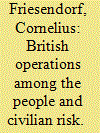

|
|
|
|
|
| Summary/Abstract |
Debates on military intervention and small wars often include the claim that soldiers should operate among civilians in order to avoid civilian casualties and to protect civilians against third-party violence. This article, by contrast, points at negative unintended consequences of military operations taking place in close proximity to local populations: it argues that also risk-tolerant militaries cause civilian casualties and that their presence triggers third-party violence against civilians. The British military, in particular the British Army, exported risk-tolerant practices from Northern Ireland to the Balkans, with sporadic success. But in southern Iraq and in Helmand, British ground operations harmed civilians. The findings suggest that the chances for protection are better in operations where levels of violence are relatively low than in counterinsurgency where troops face ruthless and well-endowed enemies operating among civilians.
|
|
|
|
|
|
|
|
|
|
|
|
|
|
|
|
| 2 |
ID:
097948
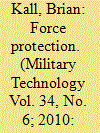

|
|
|
| 3 |
ID:
113111
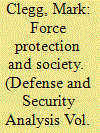

|
|
|
|
|
| Publication |
2012.
|
| Summary/Abstract |
Wars have long been fought with a firm focus upon armies' domestic contexts. These socio-political foundations have underpinned decisions regarding embarking upon war as well the conduct of war itself. Of particular importance among liberal democracies is the emphasis which is now placed upon force protection; broadly conceived as the range of measures employed to ensure the protection of servicemen and women on operations. Decisions surrounding protective equipment, deployed locations and wartime activities all face detailed scrutiny in contemporary operating environments. The attitudes of the government, the military and the civilian population combine to create a complex and dynamic backdrop of harmony and tension to this most sensitive characteristic of modern wars.
|
|
|
|
|
|
|
|
|
|
|
|
|
|
|
|
| 4 |
ID:
076649
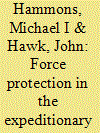

|
|
|
| 5 |
ID:
189958
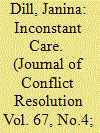

|
|
|
|
|
| Summary/Abstract |
The choice between protecting friendly soldiers or foreign civilians is a critical strategic dilemma faced in modern war. Prevailing theories suggest that casualties among both groups depress war support in Western democratic societies. Yet we know little about how ordinary citizens balance force protection and civilian casualty avoidance, and whether public opinion differs across Western democracies. Using survey experiments, we test three micro-foundations for what we call individuals’ “harm-transfer preferences:” self-interest, perception of soldiers’ consent to risk-taking, and nationalism. We find that respondents’ perception of soldiers’ consent and respondents’ nationalism explain individual-level variation in harm-transfer preferences. Moreover, Israeli citizens are significantly more likely than American or British citizens to prefer protecting friendly forces over avoiding foreign civilian casualties. This is associated with higher levels of nationalism and the perceptions that soldiers do not consent to risking their lives in Israel compared to the United States and the United Kingdom.
|
|
|
|
|
|
|
|
|
|
|
|
|
|
|
|
| 6 |
ID:
086803
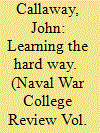

|
|
|
|
|
| Publication |
2009.
|
| Summary/Abstract |
Since the attack on Khobar Towers in June 1996, the Department of Defense (DoD) has made significant improvements in protecting its service members, mainly in deterring, disrupting and mitigating terrorist attacks on installations. The attack on USS Cole (DDG 67), in the port of Aden, Yemen, on 12 October 2000, demonstrated a seam in the fabric of efforts to protect our forces, namely in-transit forces.
|
|
|
|
|
|
|
|
|
|
|
|
|
|
|
|
| 7 |
ID:
081992
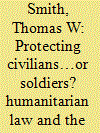

|
|
|
|
|
| Publication |
2008.
|
| Summary/Abstract |
The level of non-combatant casualties in modern Western warfare is determined in large part by the way in which policymakers apportion risk between soldiers and civilians. In the U.S. counterinsurgency in Iraq, a "kinetic" strategy and a muscular doctrine of force protection have lowered the threshold for the use of violence and, in many cases, transferred risk from soldiers to civilians. Particularly in areas deemed hostile, aggressive tactics make up for a shortage of soldiers on the ground and direct violence toward non-combatants. This is not the fog of war: even unintended civilian casualties flow predictably from policy choices. Perceptions of risk increasingly govern U.S. interpretations of its humanitarian obligations under international law, threatening to dilute the doctrine of proportionality and reverse the customary and legal relationship between combatants and non-combatants. Only late in the war has the U.S. administration recalibrated risks and launched a more orthodox counterinsurgency strategy
|
|
|
|
|
|
|
|
|
|
|
|
|
|
|
|
| 8 |
ID:
138802
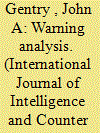

|
|
|
|
|
| Summary/Abstract |
Warning intelligence has traditionally focused on indicators of major military attacks by states against other states. In the United States, the lessons of the Japanese attack on Pearl Harbor in 1941 and the long rivalry with the Soviet Union produced an “indications and warning” (I&W) methodology that studied the military forces and doctrines of potential enemies in order to develop indicators of likely attack. When those indicators were present, a warning message was considered prudent. The classic statement of this approach is Cynthia Grabo's Handbook of Warning Intelligence.
|
|
|
|
|
|
|
|
|
|
|
|
|
|
|
|